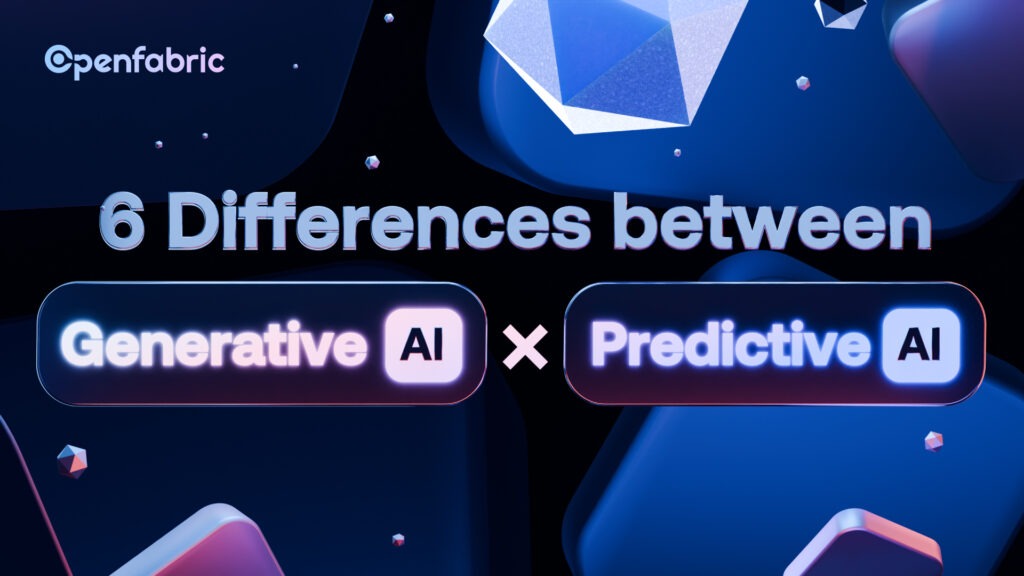
June 27, 2025 6 minutes read
6 Differences between Generative AI and Predictive AI?

If you go out in the streets and ask a bunch of people what AI is used for, most will list functions such as generating essays, answering queries, or generating pictures. A few might go out on a limb to suggest functions such as writing or correcting codes, but these most likely will be tech-savvy individuals. The point is that for people not actively involved in the technology industry, the functions of AI might be lost or mixed up completely. The industry where an individual works also contributes to how much they know about AI. For example, a weather person might suggest predictive functions of AI rather than its generative functions. So will a doctor or traders who use AI to optimize their trade.
All these are functions of two key types of AI; Generative AI and Predictive AI. However, their functions may intertwine which is why knowing the differences between generative AI and predictive AI matters.
Knowing the function of a specific type of AI helps you to tailor your needs exactly to that AI. It also helps the AI serve you better and produce the relevant and desired results. Some AI, like generative AI, can create things from scratch, while others, like predictive AI, are better suited for anticipating the outcomes of events. Both are very valuable and push us further to achieve our goals. Their distinctive functions set them apart, and that is why in this article we will discuss the main differences between generative AI and predictive AI.
Let’s get started!
What is Generative AI?
Generative AI is an artificial intelligence model that can create new content and media like images, texts, videos, music, and even codes. But, its functions do not end there. It also provides replies to queries or questions about a particular subject matter. However, for the sake of our comparison, we will focus more on the content generation aspects of generative AI.
How does generative AI work?
This is where it gets a little more complex and technical. However, the working process of generative AI is pretty simple. On the surface level, generative AI models are trained on large quantities of existing content to enable them to produce new content. With these data sets, they learn how to identify patterns based on probability distribution, and when given a prompt, create similar patterns as outputs.
On a deeper level, generative AI uses a neural network that allows it to learn from and recognize complex patterns. Just like the human brain, these neural networks allow generative AI models to provide creative and relevant content with minimal or no human intervention or supervision.
In addition to neural networks, generative AI models also have natural language processing (NLP). This allows them to understand human text, instead of the 1s and 0s that computers use. Therefore, the results provided are contextual and relevant to the prompt.
Common use of Generative AI is seen in industries such as education, marketing, entertainment, finance, and medicine.
What is Predictive AI?
The word “predictive” already gives it away. Predictive AI does not create; it forecasts or predicts. It is designed to analyze present and historical data, and then make highly accurate guesses on the outcome of an event or what is about to happen next. For example, when you ask Siri what the weather is going to be like today, you are using predictive AI.
How does Predictive AI work?
The main thing to note is that predictive AI takes statistical analysis and merges it with machine learning (ML) to identify patterns, anticipate behaviors, and forecast upcoming events, basically.
In more details, predictive AI needs a vast amount of data together with subsets of AI algorithms to accurately predict outcomes. The subsets of AI algorithms include:
- Neural networks: they can learn complex patterns from large data sets
- Linear and logistic regression: linear regression enables the model to identify relationships between variables, while logistic regression enables the model to categorize data into distinct groups.
- Support Vector Machines (SVMs): they are also used for classification, offering a better performance in scenarios with clear margin separations.
- Decision trees: decision trees estimate outcomes by splitting data into branches based on feature values, therefore, improving the accuracy of classification.
- K-means clustering: this is another subset that sorts data into groups based on their similarities. It helps the model to predict more accurately through the discovery of underlying patterns within the data.
The accuracy of predictive AI models depends heavily on the accuracy of the historical data. In addition, the choice of algorithm used depends on the nature of the data and the type of prediction being made.
Some everyday applications of predictive AI include; E-commerce for recommending products or services based on past market behavior, healthcare in the prediction of patient outcomes, and the most popular, weather forecasting.
What are the differences between Generative AI and Predictive AI?
Generative AI and Predictive AI are revolutionary AI models that find applications in almost every industry. However, they have major differences that make them more suitable for specific applications. The differences between generative AI and predictive AI are based on six main parameters such as:
Common use
One of the main differences between Generative AI and Predictive AI is its use. As stated earlier, generative AI is used for the creation of new content. This includes articles or essays, videos, images, and so on. On the other hand, predictive AI helps to forecast future outcomes based on analysis of historical data.
Data utilization
Generative AI uses patterns from vast amounts of data to generate similar outputs based on the prompt input. However, the data in predictive AI learns from both present and historical data to predict future trends or events.
Applications
The content generated by Generative AI can be used as social media content, in personal essays, art, advertising, or just for entertainment. In a way, the situation is different for predictive AI. Predictive AI, in most cases, has a more personal application. For example, in predicting the weather conditions of the day. On a larger scale, financial institutions utilise predictive AI to forecast stock markets, resulting in improved trading outcomes.
Output
For generative AI, the output can be texts, images, audio, codes, and so on, while the output in predictive AI includes statistics, probabilities, and classifications.
Methodologies and techniques
The differences between Generative AI and Predictive AI are further solidified by the different techniques used by both models. Generative AI uses neural networks and GANs, while predictive AI utilizes subsets of machine learning algorithms such as linear and logic regression and decision trees.
Metrics for evaluation
Both Generative and Predictive AI are large language models (LLMs). As such, their performance must be evaluated. However, different evaluation metrics are used to evaluate the performance of Generative and Predictive AI models.
Generative AI models are primarily evaluated based on the quality of the text. Here, the ROUGE evaluation metrics are used. Predictive AI, on the other hand, is evaluated based on metrics such as accuracy, recall, and the F1 score.
Read more on THE EVALUATION OF LLM PERFORMANCE.
Eventually, the choice of which AI model to use depends on the application of it. However, the function of one does not interfere with the function of the other. Therefore, despite the differences between Generative AI and Predictive AI, they can be used together and may even complement each other in some use cases.
Conclusion
Artificial Intelligence is not a one-size-fits-all tool. The differences between Generative AI and Predictive AI do not make any of them more useful than the other. It only highlights where their strengths lie and helps us maximize their use. The best part? You don’t have to be some tech wiz to benefit from AI. Just pick the one model that serves you best at that moment, sit back, and enjoy the ride.
Get more AI-related insights from our WEBSITE today!

